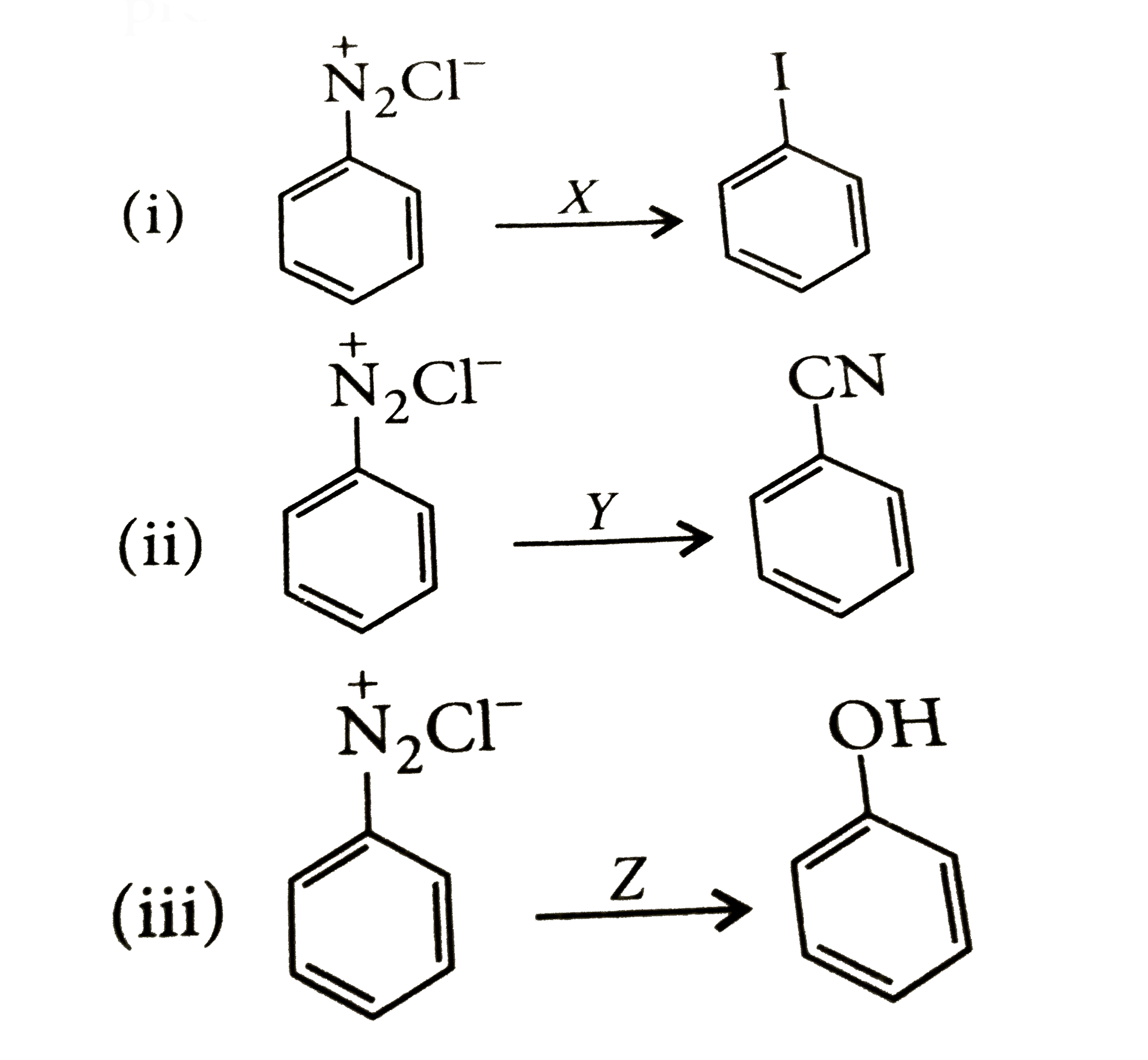X+AgNO3→Y (white ppt.)
Y is soluble in nitric acid an ammonia. The ppt. becomes yellowish brown upon addition of excess reagent owing to the formation of Z. If aqueous suspension of Y is boiled then it gives same product Z.
Here Z is:
Ag2CO3
Ag
Ag2O
all of these
The correct Answer is:C
X→CO2−3,Y→Ag2CO3,Z→Ag2O
Topper's Solved these Questions
- BOOK - GRB PUBLICATIONCHAPTER - SALT ANALYSISEXERCISE - Comprehension 21videos
SALT ANALYSIS
- BOOK - GRB PUBLICATIONCHAPTER - SALT ANALYSISEXERCISE - Comprehension 31videos
SALT ANALYSIS
- BOOK - GRB PUBLICATIONCHAPTER - SALT ANALYSISEXERCISE - Comprehension 11videos
SALT ANALYSIS
- BOOK - GRB PUBLICATIONCHAPTER - S BLOCK ELEMENTSEXERCISE - SUBJECTIVE TYPE9videos
S BLOCK ELEMENTS
- BOOK - GRB PUBLICATIONCHAPTER - THERMODYNAMICSEXERCISE - All Questions704videos
THERMODYNAMICS
Similar Questions
Identify the reagents X,Y and Z for the following products.
 View Solution
View Solutionp-Amino-N,N-dimethylaniline is added to a strongly acidic solution of X. the resulting solution is treated with a few drops of aqueous solution of Y to yield blue colouration due to the formation of methylene blue. Treatment of the aqueous solution of Y with the reagent potassium hexacyanoferrate (II) leads to the formation of an intense blue precipitate. The precipitate dissolves on excess addition of the reagent. Similarly, treatment of the solution of Y with the solution of potassium hexacyanoferrate (III) leads to a brown colouration due to the formation of Z.
The compound Z is:View Solution
Knowledge Check
- Question 1 - Select One
X+AgNO3→Y (white ppt.)
Y is soluble in nitric acid an ammonia. The ppt. becomes yellowish brown upon addition of excess reagent owing to the formation of Z. If aqueous suspension of Y is boiled then it gives same product Z.
Her, X and Y are:ACO2−3 and Ag2OBCO2−3 and Ag2CO3CHCO−3 and Ag2CO3DHCO−3 and Ag2O - Question 2 - Select One
'X'+AgNO3→'Y' (yellowish white ppt) 'Y' is soluble is nitric acid and ammonia. The ppt. becomes yellowish brown upon addition of excess reagent owing to the formation of 'Z'. If aqueous suspension of 'Y' is boiled then it gives the same product 'Z'.
Here 'Z' is:AAg2CO3BAgCAg2ODall of these - Question 3 - Select One
'X'+AgNO3→'Y' (yellowish white ppt) 'Y' is soluble is nitric acid and ammonia. The ppt. becomes yellowish brown upon addition of excess reagent owing to the formation of 'Z'. If aqueous suspension of 'Y' is boiled then it gives the same product 'Z'.
Here 'X' and 'Y' are:ACO2−3 and Ag2OBCO2−3 and Ag2CO3CHCO−3 and Ag2CO3DHCO−3 and Ag2O
p-Amino-N, N-dimethylaniline is added to a strongly acidic solution of X. The resulting solution is treated with a few drops of aqueous solution of Y to yield blue coloration due to the formation of mothylene blue. Treatment of the aqueous solution of Y with the reagent potassium hexacyanoferrate (II) leads to the formation of an intense blue precipitate. The precipitate dissolves on excess addition of the reagent. Similarly, treatment of the solution of Y with the solution of potassium hexacyanoferrate (III) leads to a brown coloration due to the formation of Z.
Q The compound Z isView Solutionp-Amino-N,N-dimethylaniline is added to a strongly acidic solution of X. the resulting solution is treated with a few drops of aqueous solution of Y to yield blue colouration due to the formation of methylene blue. Treatment of the aqueous solution of Y with the reagent potassium hexacyanoferrate (II) leads to the formation of an intense blue precipitate. The precipitate dissolves on excess addition of the reagent. Similarly, treatment of the solution of Y with the solution of potassium hexacyanoferrate (III) leads to a brown colouration due to the formation of Z.
The compound Y is:View Solutionp-Amino-N, N-dimethylaniline is added to a strongly acidic solution of X. The resulting solution is treated with a few drops of aqueous solution of Y to yield blue coloration due to the formation of mothylene blue. Treatment of the aqueous solution of Y with the reagent potassium hexacyanoferrate (II) leads to the formation of an intense blue precipitate. The precipitate dissolves on excess addition of the reagent. Similarly, treatment of the solution of Y with the solution of potassium hexacyanoferrate (III) leads to a brown coloration due to the formation of Z.
Q The compound Y isView Solutionp-Amino-N,N-dimethylaniline is added to a strongly acidic solution of X. the resulting solution is treated with a few drops of aqueous solution of Y to yield blue colouration due to the formation of methylene blue. Treatment of the aqueous solution of Y with the reagent potassium hexacyanoferrate (II) leads to the formation of an intense blue precipitate. The precipitate dissolves on excess addition of the reagent. Similarly, treatment of the solution of Y with the solution of potassium hexacyanoferrate (III) leads to a brown colouration due to the formation of Z.
The compound X is:View Solutionp-Amino-N, N-dimethylaniline is added to a strongly acidic solution of X. The resulting solution is treated with a few drops of aqueous solution of Y to yield blue coloration due to the formation of mothylene blue. Treatment of the aqueous solution of Y with the reagent potassium hexacyanoferrate (II) leads to the formation of an intense blue precipitate. The precipitate dissolves on excess addition of the reagent. Similarly, treatment of the solution of Y with the solution of potassium hexacyanoferrate (III) leads to a brown coloration due to the formation of Z.
Q The compound X isView Solution

